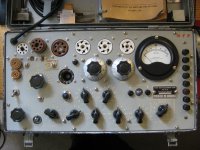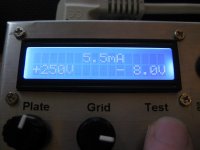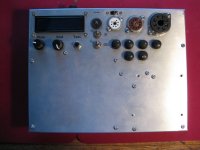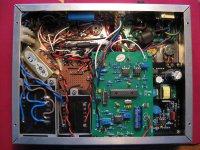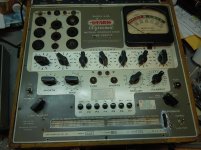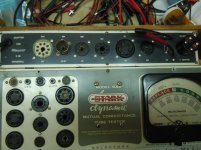My first tester was a DIY kit from eBay which works great. I recently added in a curve tracer module from the same seller which also works great. See thread here for discussion on his testers. http://www.diyaudio.com/forums/equi...-tester-ebay-experience-build-mod-thread.html
My second unit is a vintage TV-7 tester which is a rather lovely bit of kit
My second unit is a vintage TV-7 tester which is a rather lovely bit of kit
Attachments
Hi tubelectron,
What a beautiful collection! I have a few, but nothing like yours. Being in Canada, I use a Stark 9-66 which looks like a Hickok, but not quite. It's built under license from Hickok.
It's nice to see everyone's tube testers, all of them are pretty cool.
-Chris
What a beautiful collection! I have a few, but nothing like yours. Being in Canada, I use a Stark 9-66 which looks like a Hickok, but not quite. It's built under license from Hickok.
It's nice to see everyone's tube testers, all of them are pretty cool.
-Chris
Thanks Chris "anatech" and skidave !
Yes, the STARK models are none other than HICKOK models - I believe that the brand STARK was set up for the Canadian market. And the 800A is a good unit, comparable to the 600 about the functions, but showing reject point values like the 539, and not AVG values like the 600, AFAIR.
I had 2 Hickok 6000, one 752A, one 539B with a CA-4 adaptor, a Knight 600, a Triplett 3423, a Conar 221, an EMC 211, a Superior TV-11... But none of them were more interesting or worked better than the ones I kept - even after complete restoration and calibration to their specs.
The 6000 were plagued by meter reliability problems...
The 752A was a nice machine but I have a 539C...
The 539B was too, but having a 539C...
I should have kept the CA-4 ! I thought that the 539C did not needed it, having the Compactron socket...
The Knight 600 and the Conar 221 gave questionable, not to say unreliable results.
The Superior TV-11 wasn't better than the National NRI-70...
The little EMC 211 was not bad, but not very useful, and thanks to its "tiny toy" look, it sold easily !
The Triplett 3423 was a nice unit but it has failure in its design that gave unreliable (not to say random) measurements...
Some nice pics of my 1964 539C that I restored completely :
A+!
Yes, the STARK models are none other than HICKOK models - I believe that the brand STARK was set up for the Canadian market. And the 800A is a good unit, comparable to the 600 about the functions, but showing reject point values like the 539, and not AVG values like the 600, AFAIR.
I had 2 Hickok 6000, one 752A, one 539B with a CA-4 adaptor, a Knight 600, a Triplett 3423, a Conar 221, an EMC 211, a Superior TV-11... But none of them were more interesting or worked better than the ones I kept - even after complete restoration and calibration to their specs.
The 6000 were plagued by meter reliability problems...
The 752A was a nice machine but I have a 539C...
The 539B was too, but having a 539C...
I should have kept the CA-4 ! I thought that the 539C did not needed it, having the Compactron socket...
The Knight 600 and the Conar 221 gave questionable, not to say unreliable results.
The Superior TV-11 wasn't better than the National NRI-70...
The little EMC 211 was not bad, but not very useful, and thanks to its "tiny toy" look, it sold easily !
The Triplett 3423 was a nice unit but it has failure in its design that gave unreliable (not to say random) measurements...
Some nice pics of my 1964 539C that I restored completely :
An externally hosted image should be here but it was not working when we last tested it.
An externally hosted image should be here but it was not working when we last tested it.
An externally hosted image should be here but it was not working when we last tested it.
An externally hosted image should be here but it was not working when we last tested it.
A+!
Hi tubelectron,
Yours looks very much like mine, except I don't have the two meters on the left. I have a TV\2u to restore as well, along with some other Stark and B&K tube checkers (you can't call them testers).
The roll chart mechanism seems to be the most problematic with these testers. I eventually took one out and copied it like a book. That is faster, a lot faster. I have mis-placed the tester I use most often, and the copied chart with it.
-Chris
Yours looks very much like mine, except I don't have the two meters on the left. I have a TV\2u to restore as well, along with some other Stark and B&K tube checkers (you can't call them testers).
The roll chart mechanism seems to be the most problematic with these testers. I eventually took one out and copied it like a book. That is faster, a lot faster. I have mis-placed the tester I use most often, and the copied chart with it.
-Chris
Yes, Chris.
Without the 2 smaller meters, your STARK is then probably the equivalent to the HICKOK 533 below, IMHO. A picture of your unit could tell...

The 533 is a very good instrument, same as the 600 and even better because it has an additional Gm range selector instead of only having the English pot (more touchy). The 533 has the same bakelite meter as the 600 and the same roll-charts indicating the more interesting AVG values. The "A" versions have the plastic lower quality meter and Reject Point values (533A, 600A).
The Roll-Charts are scarce, and the ones that you found are often old or recent ones, that is to say not very complete or full of odd TV tubes. I am not sure that there are repros convenient for a swap. So having copies in the handbook form is then interesting, and most of them are complete and available for free download on the web.
Fortunately, my Hickok 600 has a big and very complete roll-chart, my 539C is big too, but doesn't lists oldies like the 6SL7 for example...
A+!
Without the 2 smaller meters, your STARK is then probably the equivalent to the HICKOK 533 below, IMHO. A picture of your unit could tell...

The 533 is a very good instrument, same as the 600 and even better because it has an additional Gm range selector instead of only having the English pot (more touchy). The 533 has the same bakelite meter as the 600 and the same roll-charts indicating the more interesting AVG values. The "A" versions have the plastic lower quality meter and Reject Point values (533A, 600A).
The Roll-Charts are scarce, and the ones that you found are often old or recent ones, that is to say not very complete or full of odd TV tubes. I am not sure that there are repros convenient for a swap. So having copies in the handbook form is then interesting, and most of them are complete and available for free download on the web.
Fortunately, my Hickok 600 has a big and very complete roll-chart, my 539C is big too, but doesn't lists oldies like the 6SL7 for example...
A+!
Hi tubelectron,
At long last, here is my 9-66 with the socket adapter wired right in. Sorry for the poor quality pictures, but you get the idea of this thing.
These have served me well, and I have a TV-2/u I need to restore. That one is all adjustments and meters. I assume you set it up per the tube manual for the tube type. I'll know more after I get through it.
For this type of tester, I normally plug it into a variac, turn the line voltage adjust pot full up and set the output voltage to the "set" mark. I find I'm not constantly adjusting the line voltage and it stays closer to the cal voltage when testing power tubes. I think these use an 83 and a 5Y3 or similar, both rectifiers.
I am thinking of modifying one of these testers for a signal source (calibrated) and maybe DC supply voltages instead of the pulsing DC it now uses. Comments?
-Chris
At long last, here is my 9-66 with the socket adapter wired right in. Sorry for the poor quality pictures, but you get the idea of this thing.
These have served me well, and I have a TV-2/u I need to restore. That one is all adjustments and meters. I assume you set it up per the tube manual for the tube type. I'll know more after I get through it.
For this type of tester, I normally plug it into a variac, turn the line voltage adjust pot full up and set the output voltage to the "set" mark. I find I'm not constantly adjusting the line voltage and it stays closer to the cal voltage when testing power tubes. I think these use an 83 and a 5Y3 or similar, both rectifiers.
I am thinking of modifying one of these testers for a signal source (calibrated) and maybe DC supply voltages instead of the pulsing DC it now uses. Comments?
-Chris
Attachments
- Status
- This old topic is closed. If you want to reopen this topic, contact a moderator using the "Report Post" button.
- Home
- Design & Build
- Equipment & Tools
- Vacuum tube tester, do you own one?
